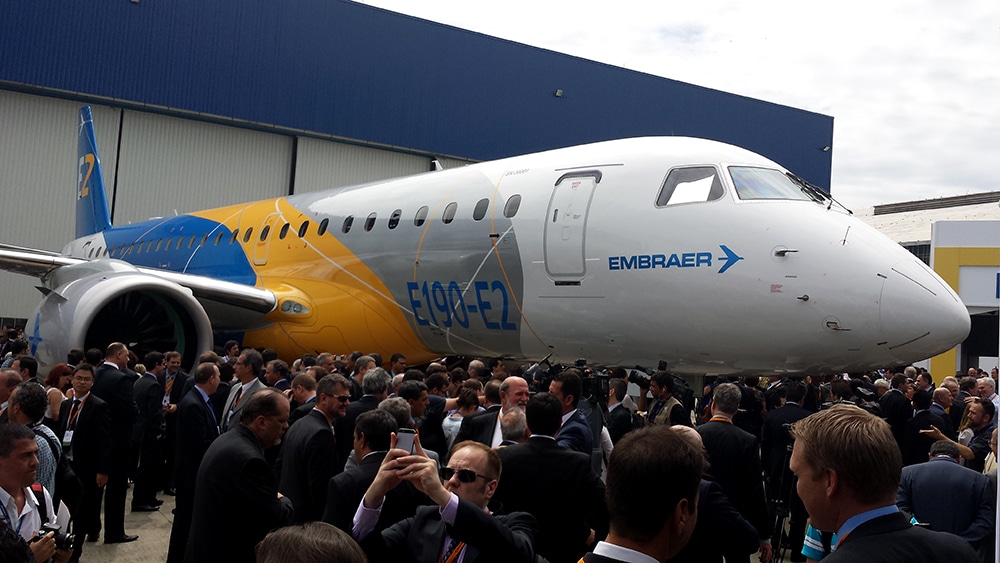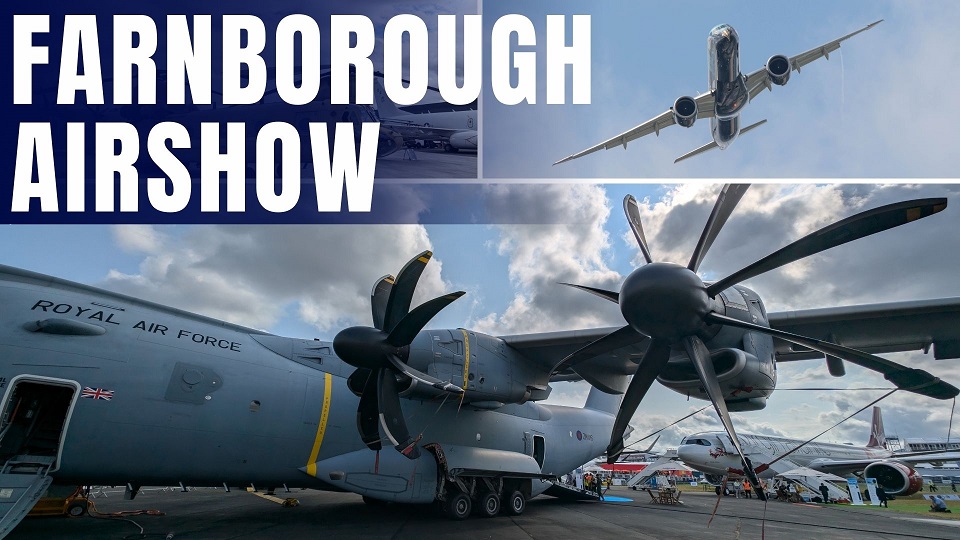Aviation
First New-Generation Embraer E190-E2 Rolls Out.

São José dos Campos, Brazil, February 25th, 2016 – Embraer, the world’s leading manufacturer of commercial jets up to 130 seats, today took a step in the consolidation of its leadership by presenting the E190-E2, the first E2 jet – Embraer´s second generation of the E-Jets family of commercial aircraft. The aircraft´s maiden flight is scheduled for the second half of 2016, with entry into service scheduled for 2018. The ceremony was held at the Company´s plant in São José dos Campos.
“Today we have taken another step into the future of Embraer commercial aviation with the world premiere of our second-generation E-Jets,” said Paulo Cesar Silva, President & CEO, Embraer Commercial Aviation. “I’m sure that as a result of this event, the market´s interest in the E2 will grow even further, increasing the commercial success of this program throughout the world.”
With an investment of USD 1.7 billion, the E2 program was launched in June 2013 and reinforces Embraer’s commitment to continuously invest in its commercial aviation products as well as maintain market leadership in the segment of 70 to 130 seats. The aircraft will have state-of-the-art engines, which, combined with new aerodynamically advanced wings, full fly-by-wire flight controls, and improvements to other systems, will deliver significant reductions in fuel burn, maintenance costs, emissions, and external noise.
Since the E2 was launched, the program has reached 640 commitments, 267 of which are firm orders and 373 of which are options and purchase rights, from both airline customers and leasing companies. Currently, the E-Jets are operating with about 70 customers in 50 countries and, with over 50% market share, they are the global leader in the segment of aircraft with up to 130 seats.
“The rollout held today marks the completion of the assembly of the first E190-E2 and paves the way for the start of the tests that will lead to the first flight,” said Luís Carlos Affonso, Senior Vice President Operations & COO, Embraer Commercial Aviation. “We are delighted to reach this phase of the program, considering all of the technical and economic objectives set out at its inception.”
This aircraft is the first of four prototypes that will be used in the E190-E2 certification campaign. Two additional planes will be added for the E195-E2 campaign, entry into service for which is expected in 2019, and three more will be used in the E175-E2 campaign, which is scheduled to enter service in 2020.
The E190-E2 has the same number of seats as the current generation E190 and can be configured with 97 seats in dual class service or with 106 seats in a single class layout. Additionally, the range of the E190-E2 has been significantly increased over the current generation aircraft, by 400 nautical miles, with the capacity to cover distances of 2,800 nautical miles.
Embraer press .

Aviation
Farnborough 2024: A Landmark Airshow Concludes with £81.5 Billion in Deals

As the 45th edition of the Farnborough International Airshow (FIA2024) concluded, it proved to be a tremendous success. The event, which ended yesterday, saw £81.5 billion worth of deals signed and 260 firm commercial aircraft orders placed within the first four days. For the UK alone, the deals announced amounted to £13 billion.
The show ended with an exhilarating final air display. The Starlings Aerobatic Team performed an impressive formation flight, while the Stampe Formation team showcased their vibrant heritage aircraft. The Royal Air Force’s F-35 flyover and the F-15QA’s powerful farewell flight added to the excitement. The British Army’s renowned Red Devils parachuted down, providing a spectacular closing to the event.
Day 2 Highlights: Airbus, Boeing, and Embraer Orders at Farnborough International Airshow 2024 : Click here
With this year’s orders finalized, the focus on the fifth and final day of FIA2024 shifted to inspiring the next generation of pilots, engineers, manufacturers, and innovators. We eagerly anticipate seeing everyone again at the Farnborough International Airshow 2026.
Airbus Expands Reach with Major Orders
Airbus has secured two significant deals that will expand its presence in the global market. The Abra Group, aiming to enhance its international long-haul operations, signed a Memorandum of Understanding (MoU) for five A350-900 aircraft. Additionally, flynas, Saudi Arabia’s leading low-cost carrier, strengthened its partnership with Airbus by signing an MoU for 75 A320neo family aircraft and 15 A330-900s.
Embaer Aircraft
In the military aviation sector, Embraer announced a major order from the Paraguayan Air Force (FAP) for six A-29 Super Tucano aircraft. This versatile, multi-mission aircraft will enhance the FAP’s capabilities in armed reconnaissance, close air support, light attack, and advanced training missions.
Virgin Atlantic also made headlines by ordering seven additional A330neo aircraft. This order highlights the airline’s confidence in the A330neo’s performance and passenger comfort, as well as its commitment to sustainability. The advanced technology and fuel efficiency of the A330neo make it an ideal choice for Virgin Atlantic’s transatlantic operations, aligning with their goal of providing an enhanced and eco-friendly travel experience.
Boeing aircraft.
Boeing also had a notable presence on Day 2 of the airshow. Qatar Airways announced an order for 20 additional 777-9 airplanes, reinforcing its commitment to the 777X program. The 777-9, touted as the world’s largest and most fuel-efficient twin-engine jet, is set to play a crucial role in Qatar Airways‘ long-haul fleet expansion, offering increased passenger capacity and improved fuel efficiency.
In a significant move for the leasing sector, Macquarie AirFinance announced its first direct order with Boeing, purchasing 20 737-8 aircraft. This order not only doubles Macquarie AirFinance’s existing 737-8 order book, acquired from ALAFCO Aviation Lease and Finance Co. in 2023, but also underscores the continued strong demand for the 737 MAX family, known for its efficiency and versatility.
-

 Travel1 week ago
Travel1 week agoAir India to Expand US Operations with Three New Routes After a Decade
-

 Travel2 weeks ago
Travel2 weeks agoWhy We Should Avoid These Stamps in a Passport
-

 Airlines1 month ago
Airlines1 month agoInvestigations Reveal Fake Chinese Titanium in Boeing and Airbus Jets
-

 Tech4 weeks ago
Tech4 weeks agoChina’s CATL Plans 1,800-Mile Electric Plane Launch by 2027
-

 Airport3 days ago
Airport3 days agoTop 10 Largest Airports in the World by Size
-

 Aerospace4 weeks ago
Aerospace4 weeks agoChina’s Fighter Jets Turn Wings into Autonomous Drones
-

 Airlines4 days ago
Airlines4 days agoAir India Rolls Out A350s for Delhi-New York JFK and Newark Routes
-

 Defence3 weeks ago
Defence3 weeks agoBoeing Enhances Chinook with New Engines and Block II Upgrades at $96 Million







